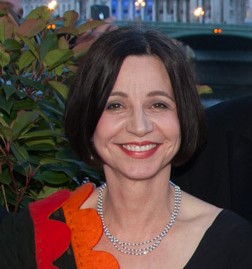Interview: Dr. E. Jane Adam, chair of the ESR Quality, Safety & Standards Committee
One of the ESR’s statutory committees underwent two subtle changes earlier this year; its interim chair was officially elected as chairperson, and its name was changed. We spoke to Dr. E. Jane Adam, Chair of the newly re-named ESR Quality, Safety and Standards Committee, to find out a little bit about her role, the committee’s function, and some of the key items on its agenda.
ESR Office: What is the overall purpose of the ESR Quality, Safety and Standards (QSS) Committee and how does it operate?
E. Jane Adam: The committee has several subcommittees and working groups covering radiation protection, audit and standards, management in radiology, e-health and informatics, ethics, ultrasound and a European Medicines Agency task force. They are all active in their various areas, undertaking projects, producing documents on behalf of the ESR, and liaising with other organisations. However, the aim of the committee as a whole is to promote high standards of radiology and, by working together, with cross fertilisation of ideas, the committee becomes greater than the sum of its parts.

Dr. E. Jane Adam, consultant in diagnostic radiology at St. George’s Hospital, London, and chair of the ESR Quality, Safety & Standards Committee.
ESR: What is your background within the ESR committee structure and what motivates you to be involved?
EJA: I first became involved in the work of the ESR when I became chair of the Audit and Standards Subcommittee when it was first formed. This probably came about because I had chaired both the audit and standards committees of the Royal College of Radiologists in the UK. I have more recently been elected to chair the ‘parent’ QSS Committee. I have a long standing interest in these topics, and also wider professional issues in radiology from being chairman of a very large radiology department where I became very aware of the challenges for radiologists when the demands on radiology departments are increasing all the time, expectations are extremely high, and we rarely have the resources or manpower which we would like in order to provide the highest quality service.
ESR: What are the main issues currently on the committee’s agenda, and how are they being tackled?
EJA: There are lots of them! Radiation protection is a very big theme with the launch of the EuroSafe Imaging campaign, but we are also working on providing people with straightforward ways of carrying out clinical audit in their departments, the requirement for which is enshrined in the Euratom EU directive, and sounds rather difficult if you are not doing it already, but can be made quite routine. The promotion of ultrasound as an imaging technique which avoids radiation exposure is another workstream. Teleradiology is becoming more prevalent, and politically is a very hot and rather contentious topic, particularly the outsourcing of reporting. The committee is embarking on a quest to find out what is really happening in Europe, and what are the concerns and implications for service provision and training.
ESR: What new issues do you think the QSS Committee will be dealing with in the coming years?
EJA: I hope that the committee will be alert and responsive to changes in the practice of radiology and be able to help radiologists adapt and thrive, whatever comes along. Its aim must be to promote the highest possible quality of service to patients, and preserve our own professional standards, also helping to ensure that radiology remains an attractive and interesting specialty which attracts the best and most able doctors. Since the whole practice of medicine now seems to be so dependent on the rapid availability of imaging in order to guide management decisions, it is a huge challenge to radiology to provide high quality and even very specialist imaging on a 24-hour basis, but we need to rise to the challenge to maintain our role and importance in patient management.
ESR: Up until ECR 2014, the QSS Committee was called the Professional Organisation Committee. Can you explain why the change of name took place?
EJA: Well strictly the subcommittees always covered issues of quality and safety, but with the advent of clinical audit and all the challenges facing us, quality, safety and standards better expresses the wide remit of the committee, and is a more understandable title too!
ESR: How can ESR members learn more about the committee or contribute to the efforts of its various subcommittees, working groups and task forces?
EJA: There is a turnover of membership on all committees and if anyone has a particular interest or commitment to one of the topics covered by a subcommittee then they can contact the relevant chair and they will let you know how the recruitment process works. There are also a number of ‘members at large’ of the parent QSS committee. Information about the chairs of the subcommittees and working groups can be found on the ESR website.


